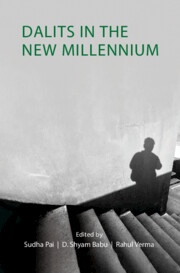Book contents
- Frontmatter
- Contents
- List of Figures
- List of Tables
- Acknowledgements
- 1 Introduction: Dalit Discourse in the New Millennium
- Part I Shifting Patterns of Electoral Politics
- Part II Popular Culture, Discourse, and Protest
- 7 Music as the Language of the Bahujan Movement: Locating the Social History of the Dalit Shoshit Samaj Sangharsh Samiti
- 8 Anti-Caste Music and Cinema
- 9 Portrayal of Dalits in the Media: A Study of Select Newspapers from Uttar Pradesh
- 10 Hierarchy in Protest: A Comparison of Dalit and Upper-Caste Agitations
- Part III Transformations in Ideology and Identity
- Part IV Aspirations and Anxieties
- Part V Discrimination and Representation
- About the Contributors
- Index
9 - Portrayal of Dalits in the Media: A Study of Select Newspapers from Uttar Pradesh
from Part II - Popular Culture, Discourse, and Protest
Published online by Cambridge University Press: 12 July 2023
- Frontmatter
- Contents
- List of Figures
- List of Tables
- Acknowledgements
- 1 Introduction: Dalit Discourse in the New Millennium
- Part I Shifting Patterns of Electoral Politics
- Part II Popular Culture, Discourse, and Protest
- 7 Music as the Language of the Bahujan Movement: Locating the Social History of the Dalit Shoshit Samaj Sangharsh Samiti
- 8 Anti-Caste Music and Cinema
- 9 Portrayal of Dalits in the Media: A Study of Select Newspapers from Uttar Pradesh
- 10 Hierarchy in Protest: A Comparison of Dalit and Upper-Caste Agitations
- Part III Transformations in Ideology and Identity
- Part IV Aspirations and Anxieties
- Part V Discrimination and Representation
- About the Contributors
- Index
Summary
A new middle class has emerged in India in the last 70 years. This change gained momentum particularly after liberalization began in 1991. Dalits, too, have become a part of this process – first due to the positive discrimination policies of the government and later due to the opportunities created by the liberal economy. However, members of this new Dalit middle class suffer, in one way or the other, from their ‘stigmatized identity’ in the caste system (Ram, 1988: 118).
The Dalit middle class has played a major role in establishing Dalit polity and asserting the identity of Dalits. Even the term ‘Dalit’ was popularized by intellectuals belonging to the Dalit middle class. With the emergence of this middle class, the number of educated Dalit youth seeking employment in the organized sectors has also increased. The first major flow was directed towards government jobs which offered reservation, but with the onset of liberalization, this trend changed. The Indian markets now saw the rise of a vibrant private sector that offered lucrative and dynamic jobs, and like the rest of society, Dalit youth, too, were drawn to the private sector. However, it was soon realized that the private sector suffered from the same malaise as the broader society – caste prejudices were carried into this new sphere as well (Thorat and Neuman, 2010). This chapter therefore delves deeper into the questions of representation of Dalits in the private sector. These questions are approached through a sample survey in media organizations in Uttar Pradesh (UP). Since media institutions form the basis of the study, the chapter further ventures into a content analysis of select newspapers for a time period of one year to understand the impact of such representation in terms of the quality and quantity of the coverage of Dalit issues. Lastly, it finds that online and social media platforms are emerging as an important alternative for the aspiring Dalit middle class.
Representation in the Newsrooms of UP
Taking media as a segment of the private sector, this study delves into the subject of representation and exclusion of Dalits. Media was chosen as the focus because it is regarded as the fourth pillar of democracy and bears the responsibility of being representative as a ‘watchdog’.
- Type
- Chapter
- Information
- Dalits in the New Millennium , pp. 150 - 165Publisher: Cambridge University PressPrint publication year: 2023
- 1
- Cited by

